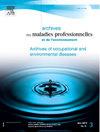2023年阿比让一家麻袋生产工厂工人的职业危害评估
IF 0.3
4区 医学
Q4 PUBLIC, ENVIRONMENTAL & OCCUPATIONAL HEALTH
Archives Des Maladies Professionnelles Et De L Environnement
Pub Date : 2025-03-20
DOI:10.1016/j.admp.2024.102823
引用次数: 0
摘要
纺织工业涵盖了一系列使工人暴露于许多职业滋扰的过程。方法在3个月的时间里,我们对阿比让一家纺织厂2023年工人的职业妨害进行了描述性横断面研究。数据是通过问卷收集的,问卷提供了社会专业特征和遇到的滋扰信息,并辅以对实际工作情况和环境测量的观察。结果共纳入职工280人,男性居多,占90.4%,平均年龄45.1±10.5岁。几乎全部为蓝领工人(98.2%),平均工龄为12.7±9.9年。工作条件的特点是尘土飞扬的环境,没有空气更新系统,拥挤的交通车道和不平坦的地板。环境测量显示噪音水平在80到97分贝之间,温度在32.1到34.1°C之间波动,粉尘浓度在0.019到1.68毫克/立方米之间,照明水平在163到878勒克斯之间。在人体工程学风险方面,62.5%的工人采取长时间站立的姿势,82.5%的工人说他们处理重物。从心理上讲,45.8%的人表示工作压力大。大多数(92.1%)受访者没有正确使用提供的个人防护装备,四分之三(75%)的人每年进行一次体检。结论该单位对职业病危害的防治必须采取集体和个人的技术措施,并辅以适当的医疗监督。本文章由计算机程序翻译,如有差异,请以英文原文为准。
Évaluation des nuisances professionnelles chez les travailleurs d’une unité de fabrication de sacs en fibres de jutes à Abidjan en 2023
Introduction
Textile industry covers a whole range of processes that expose workers to a number of occupational nuisances.
Methods
Over a period of 3 months, we carried out a descriptive cross-sectional study of the occupational nuisances of workers in a textile factory in Abidjan in 2023. Data were collected using a questionnaire providing information on socio-professional characteristics and the nuisances encountered, supplemented by observations in real work situations and ambient measurements.
Results
The study included 280 workers, mainly men (90.4%) with an average age of 45.1 ± 10.5 years. Almost all were blue-collar workers (98.2%) with an average length of service of 12.7 ± 9.9 years. Working conditions were characterised by a dusty environment with no air renewal system, congested traffic lanes and uneven floors. Environmental measurements revealed noise levels ranging from 80 to 97 dB, a temperature fluctuating between 32.1 and 34.1 °C, dust concentrations ranging from 0.019 to 1.68 mg/m3 and lighting levels ranging from 163 to 878 lux. In terms of ergonomic risk, 62.5% of workers adopted prolonged standing postures and 82.5% said they handled heavy loads. Psychologically, 45.8% reported stress at work. The majority (92.1%) of those surveyed did not use the personal protective equipment provided correctly, and three-quarters (75%) had an annual medical check-up.
Conclusion
The fight against the occupational nuisances encountered in this unit must include collective and individual technical measures as well as appropriate medical surveillance.
求助全文
通过发布文献求助,成功后即可免费获取论文全文。
去求助
来源期刊

Archives Des Maladies Professionnelles Et De L Environnement
医学-公共卫生、环境卫生与职业卫生
CiteScore
0.40
自引率
50.00%
发文量
185
审稿时长
50 days
期刊介绍:
The Archives of Occupational and Environmental Diseases (Archives des maladies professionnelles et de l''environnement) publish scientific original articles in the form of memoirs, developments and general health reviews. The journal is a reliable source of information, which lets you gain additional knowledge or update your knowledge of basic or original issues.
The section Continuous professional development focuses on a major issue and gives you the tools to optimize your practice. The content is divided in 3 parts: Reading Test, Answer to the Reading Test and Scientific Press Review, which let you share the analysis, by the editorial board, of articles from major English-language journals.
The section Legal Environment discusses an environmental culture. The section Letter to the editor keeps you informed about the press review; the Legislation, with the latest regulations published in the Official Journal; and the agenda of the meetings and the Congress, the questions–answers, etc. The Archives of Occupational and Environmental Diseases include all the scientific communications of the French occupational health societies, of which they are the official journal.
 求助内容:
求助内容: 应助结果提醒方式:
应助结果提醒方式:


